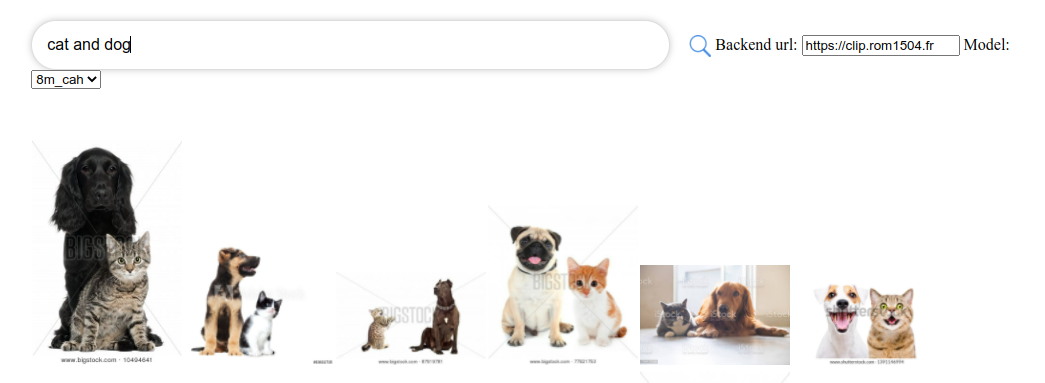Easily compute clip embeddings and build a clip retrieval system with them. 100M text+image embeddings can be processed in 20h using a 3080.
- clip inference allows you to quickly (1500 sample/s on a 3080) compute image and text embeddings
- clip index builds efficient indices out of the embeddings
- clip filter allows you to filter out the data using the clip index
- clip back hosts the indices with a simple flask service
- clip front is a simple ui querying the back. Check it out at clip-retrieval ui
End to end this make it possible to build a simple semantic search system. Interested to learn about semantic search in general ? You can read my medium post on the topic.
- cah-prepro preprocess the 400M image+text crawling at home dataset. clip-retrieval is used to compute 400M clip embeddings and the indices
- autofaiss uses clip-retrieval to display an example of use (see the multimodal notebook example there)
- afiaka87 openai demo shows how to look among the 1M example released by openai for their DALL-E demo
- antarctic-captions by dzryk uses autofaiss and clip inference as a way to generate anchors for the image to text task with great success
pip install clip-retrieval
Get some images in an example_folder, for example by doing:
pip install img2dataset
echo 'https://placekitten.com/200/305' >> myimglist.txt
echo 'https://placekitten.com/200/304' >> myimglist.txt
echo 'https://placekitten.com/200/303' >> myimglist.txt
img2dataset --url_list=myimglist.txt --output_folder=image_folder --thread_count=64 --image_size=256
You can also put text files with the same names as the images in that folder, to get the text embeddings.
Then run clip-retrieval inference --input_dataset image_folder --output_folder embeddings_folder
Output folder will contain:
- img_emb/
- img_emb_0.npy containing the image embeddings as numpy
- text_emb/
- text_emb_0.npy containing the text embeddings as numpy
- metadata/
- metadata_0.parquet containing the image paths, captions and metadata
This scales to million of samples. At 1400 sample/s of a 3080, 10M samples can be processed in 2h.
clip_inference turn a set of text+image into clip embeddings
- input_dataset Path to input dataset. Folder if input_format is files. Bash brace pattern such as "{000..150}.tar" (see https://pypi.org/project/braceexpand/) if webdataset (required)
- output_folder Folder where the clip embeddings will be saved, as well as metadata (required)
- input_format files or webdataset (default files)
- cache_path cache path for webdataset (default None)
- batch_size Number of items to do the inference on at once (default 256)
- num_prepro_workers Number of processes to do the preprocessing (default 8)
- enable_text Enable text processing (default True)
- enable_image Enable image processing (default True)
- enable_metadata Enable metadata processing (default False)
- write_batch_size Write batch size (default 10**6)
- subset_size Only process a subset of this size (default None)
- wds_image_key Key to use for images in webdataset. (default jpg)
- wds_caption_key Key to use for captions in webdataset. (default txt)
Clip index takes as input the output of clip inference and makes an index out of it using autofaiss
clip-retrieval index --input_folder embeddings_folder --output_folder index_folder
An additional --max_index_memory_usage "4G" option allow configuring the amount of ram the index will consume. More ram, better knn recall.
The output is a folder containing:
- image.index containing a brute force faiss index for images
- text.index containing a brute force faiss index for texts
- metadata folder containing the parquet metadata
Thanks to autofaiss and faiss, this scales to hundred of million of samples in a few hours.
Once the embeddings are computed, you may want to filter out the data by a specific query.
For that you can run clip-retrieval filter --query "cat" --output_folder "cat/" --indice_folder "indice_folder"
It will copy the 100 best images for this query in the output folder.
Using the --num_results or --threshold may be helpful to refine the filter
Thanks to fast knn index, this can run in real time (<10ms) for large K values (100000), and in minutes for very large K values.
Then run (output_folder is the output of clip index)
echo '{"example_index": "output_folder"}' > indices_paths.json
clip-retrieval back --port 1234 --indices-paths indices_paths.jsonA --enable_hdf5 True option can be passed to enable hdf5 caching for the metadata.
HDF5 caching makes it possible to use the metadata with almost no memory usage.
hdf5 caching is a good idea to use if:
- you do not have enough ram to load the metadata in memory
- your disk is fast (ie you have a ssd)
At this point you have a simple flask server running on port 1234 and that can answer these queries:
/indices-list-> return a list of indices/knn-servicethat takes as input:
{
"text": "a text query",
"image": "a base64 image",
"modality": "image", // image or text index to use
"num_images": 4, // number of output images
"indice_name": "example_index"
}and returns:
[
{
"image": "base 64 of an image",
"text": "some result text"
},
{
"image": "base 64 of an image",
"text": "some result text"
}
]This achieve low latency status (10ms). Throughput is about 100 query/s. For high throughput, using a grpc server is required.
Clip front is a simple UI that connects to clip back and display the results.
To run it, go to front and run npm install then npm start.
You can also directly use it at clip-retrieval ui
Either locally, or in gitpod (do export PIP_USER=false there)
Setup a virtualenv:
python3 -m venv .env
source .env/bin/activate
pip install -U pip
pip install -e .
to run tests:
pip install -r requirements-test.txt
then
python -m pytest -v tests -s


